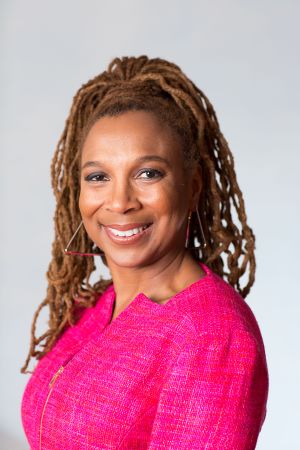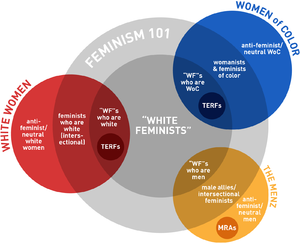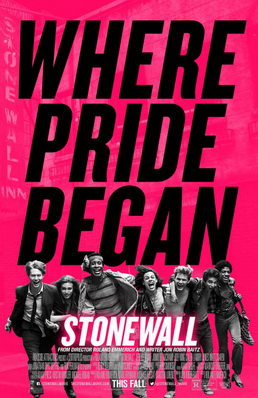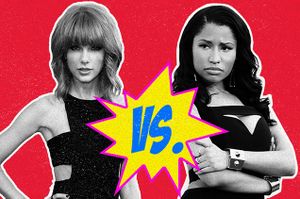White Feminism in Pop Culture and Media
Introduction to the term White Feminism
White Feminism is a term that describes a form of feminism that does not take into consideration the extent of backgrounds and narratives people may have; especially when it comes to discussions of race. In other words, White Feminism does not consider intersectionality, a term coined by a Black feminist named Kimberlé Crenshaw. Cate Young [1] offers an excellent explanation of White Feminism on her blog post where she describes it as a type of feminism that primarily approaches situations through the lens of white women, who are usually heterosexual, middle or upper-class, and able-bodied. It is also important to note, that there are several kinds of White Feminisms, for example, people of different abilities, genders, and class positions can also be White Feminists. However, the standing similarity of all these forms of White Feminism is how whiteness remains at the center; often silencing or disregarding experiences of non-white people. Considering White Feminism is a multifaceted term with several components to its definition, this page will refer to White Feminism as a singular term. Because of this, it is important to remember that “you do not have to be white or a woman to be a white feminist and not all white women are white feminists” Kerri Lyn [2]. The following diagram, provided by Young, offers a visual representation of this:
| White Feminism Visual |
|---|
Overview of White Feminism in Media
Visual representation, as explained by Stuart Hall [3] , is about depicting something that exists, therefore repeating this image. White Feminism reveals how there is a constant repetition of the images of whiteness which helps normalize the white perspective as the norm and narrative throughout the world. As a byproduct, this starts becoming the default position to take. This is due to the great exposure to media, and how much of this information is adhered. Even in literature, such as in the book ‘The Handmaid’s Tale’, by Margaret Atwood, White Feminism is used with the way that whiteness is placed at the center. This dystopian novel takes place in a world where women’s reproductive rights are policed by men. There are discussions through a White Feminist lense of class differences, homosexuality, and it also critiques the Christian religion and the way it can influence law and perceptions [4]
TV Shows
Increasingly, there are more and more TV shows gaining popularity and recognition for celebrating women and representing them as complex and elaborate characters. However, the type of women represented and celebrated for their complexities, are more often white, cisgender, middle to upper-class women. ‘Broad City’ is a show about white millennials in New York, which stars two Jewish women. It has been described in articles as “blatantly feminist” [5] for the way it promotes sex positivity, fluid sexuality, and recreational marijuana use. If in relation to white women, these are viewed as empowering feminist moves, but we do commonly see in the media how people of color are viewed as sexually deviant, unkempt, or unprofessional for the ways that they may practice sexuality, or use marijuana. Additionally, Ilana’s character in Broad City often appropriates Black and Hispanic culture throughout the show, from the way she dresses to the way she speaks, and the topics of discussion. Ilana’s western perspective is often used to make uninformed comments about different cultures and people while also upholding “liberatory” ideals for women like masturbation, body positivity and other important subjects to a White Feminist. [5].
Even when women of color are celebrated and receive the accolades they deserve for their incredible talents and roles played within pop culture, White Feminism attempts to disavow it and curb the conversation to take the spotlight. Viola Davis won an Emmy for her role of Annalise Keating in ‘How to Get Away With Murder’, and her speech acknowledged the struggle of being a woman of color in television in terms of opportunities and being recognized for complex roles that they play. Nancy Lee Graham went to twitter to say that she felt excluded from Davis’ speech, claiming that all women experienced difficulties where it comes to television. She then went on to say that Davis’ use of her platform to talk about racial injustice was inappropriate, going so far as to claim that Davis has never faced discrimination. This is an example of how White Feminism believes it always has to be included in a conversation, though whiteness so often leaves others out of the conversation [6] .
| Viola Davis Speech |
|---|
Movies
A movie, titled ‘Stonewall’ , about the stonewall riots in the late 1960s, is another example of White Feminism in the media that supposedly includes conversations about people from diverse backgrounds and their efforts but in reality, they continue being silenced. The movie is mainly critiqued for the way that cisgender actors play transgender characters. The entire premise of the movie is based on a fictional cisgender, white male as the protagonist, where the movie could have instead highlighted the many known trans women, some being people of color, who were truly there during the stonewall riots, and played valuable roles in pioneering this powerful movement [7]. This continues to perpetuate how White Feminism continues to maintain whiteness as the ideal spokesperson for various struggles and revolutions; even when it goes against history. In this case, cis male whiteness was used to silence trans experiences.
Music
Taylor Swift and Nicki Minaj, both prominent women in the music industry, became a large topic of conversation due to tweets that were shared online in 2015. Minaj, a Black, female rapper, shared her frustration in not being nominated for her record-breaking video that celebrated Black women and their bodies. She made a comment harkening to the way that Black women are rarely rewarded for the way they influence pop culture, but videos that celebrate women with slimmer frames, will instead receive recognition. Swift responded to Minaj’s tweets saying that she was dividing women, and that it was probably a man that took that nomination from her. This is yet another example of a White Feminist response, as Swift takes up space as a white woman, trying to shed whiteness of any blame, while only pointing a finger at the patriarchy. Swift silences Nicki Minaj’s experience as a Black woman, who faces the intersecting forms of oppression of being Black and facing racism, while also being a woman who faces misogyny Cite error: Invalid <ref> tag; invalid names, e.g. too many.
This example is also interesting as it highlights how the media then went on to describe Swift and Minaj’s twitter interactions. More White Feminism was seen as several articles and headlines appeared to defend Swift by villainizing Minaj and portraying Swift as a victim. Using side by side images of the two women, photos of Swift would have her smiling, while photos of Minaj would have her grimacing or not smiling, playing into the stereotype of an angry Black woman, an idea that is born out of racism and the disregard of Black women’s personhood and right to be upset about the combined racism and misogyny (source 18). White Feminism is highly problematic because of how much space it assumes, and how much attention it demands, and how authoritative it claims to be, especially over marginalized people who are fighting to be represented and received equally. Cite error: Invalid <ref> tag; invalid names, e.g. too many.
References
- ↑ http://battymamzelle.blogspot.ca/2014/01/This-Is-What-I-Mean-When-I-Say-White-Feminism.html#.WD9QgmQrL3B .
- ↑ https://goddesskerrilyn.wordpress.com/2015/10/29/the-snowflake-awards-a-review-of-white-feminism-in-popular-culture/ .
- ↑ https://www.youtube.com/watch?v=aTzMsPqssOY .
- ↑ Atwood, M. (1998). The handmaid's tale.
- ↑ Jump up to: 5.0 5.1 https://femgeniuses.com/2016/03/30/broad-city-and-one-dimensional-feminism/ .
- ↑ https://goddesskerrilyn.wordpress.com/2015/10/29/the-snowflake-awards-a-review-of-white-feminism-in-popular-culture.
- ↑ http://everydayfeminism.com/2015/09/white-cis-washing-stonewall.




